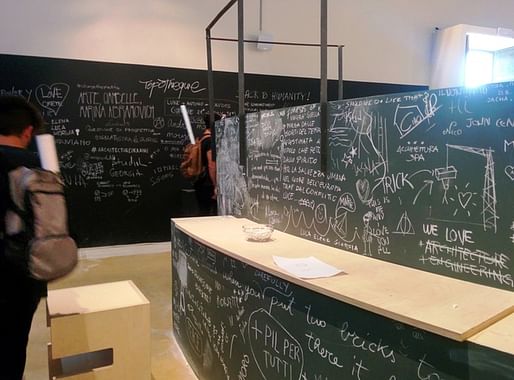
Alejandro Aravena’s brief for the Fifteenth International Architecture Exhibition at the 2016 Venice Biennale calls for projects that “are scrutinizing the horizon looking for new fields of action, facing issues like segregation, inequalities, peripheries, access to sanitation, natural disasters, housing shortage, migration, informality, crime, traffic, waste, pollution and the participation of communities.” Some curators have taken a belligerent approach, while others have used it to connect places that are geographically separated by culturally linked.
Darzanà, the Turkey Pavilion on the second floor of the Arsenale Sale d’Armi, displays a single object: a vessel. Its name, Baştarda, references the hybrid ships characteristic of Turkey and Italy from the eleventh to the nineteenth century. They are ships with no clear origin, the illegitimate children of assembled parts of undefined origin. “We want to change the negative connotation of the word,” declares Mehmet Kütükçüoğlu, one of the Pavilion’s co-curators. “So much emphasis is placed in tracing origin today; we see it as one and all.”
The vessel references the current refugee crisis in Turkey, as well as the different waves of migration throughout history. Parts scavenged from the Istanbul shipyards and then transported to Venice by boat via the Mediterranean hang from the ceiling to form a vessel out of the relationship between solid and void. As Feride Çiçekoğlu, another co-curator puts it, “the Baştarda is not only about architecture, but also about the language and the words. It’s about the journey.” The Pavilion strikes the viewer as a fairy tale suspended in time, yet invites the audience to dig deeper into the meaning of origin and of assembly. What defines our origin? What brings us together?

On the other side of the Biennale, across the canal that divides the Giardini, the Greece Pavilion also connects its Mediterranean legacy to that of Venice. #ThisIsACo-op, curated by the Association of Greek Architects, is an experiment in collaboration. Maria Kassola, from the curatorial team, explains the intent arguing that “finding solutions is a collective project, not something you do in your office.” The Pavilion opens to symmetrical amphitheaters set for debate, surrounded by black walls (and chalk) for visitors to write on. Walking past the main space, the back side features an exhibition of work that will continue growing throughout the Biennale, as well as provocative hashtags linking to the Greek crisis.
The process of curating the Greek Pavilion was a convoluted one, with changing directions and the dissolution of the selection committee. Therefore, the curators have reimagined it as a setting for ongoing conversation, which invites participants and visitors to use it as an open venue. “It would be a dream to have the visitors start an impromptu discussion here,” Kassola says enthusiastically. The pavilion will therefore host 23 parallel events across Venice and throughout Greece, broadcast on projections facing the amphitheaters to stimulate debate throughout the duration of the Biennale. The website and the hashtags at the Pavilion will contribute to building the dialogue, making the event “the beginning of a process, not the end.”

No Comments
Block this user
Are you sure you want to block this user and hide all related comments throughout the site?
Archinect
This is your first comment on Archinect. Your comment will be visible once approved.